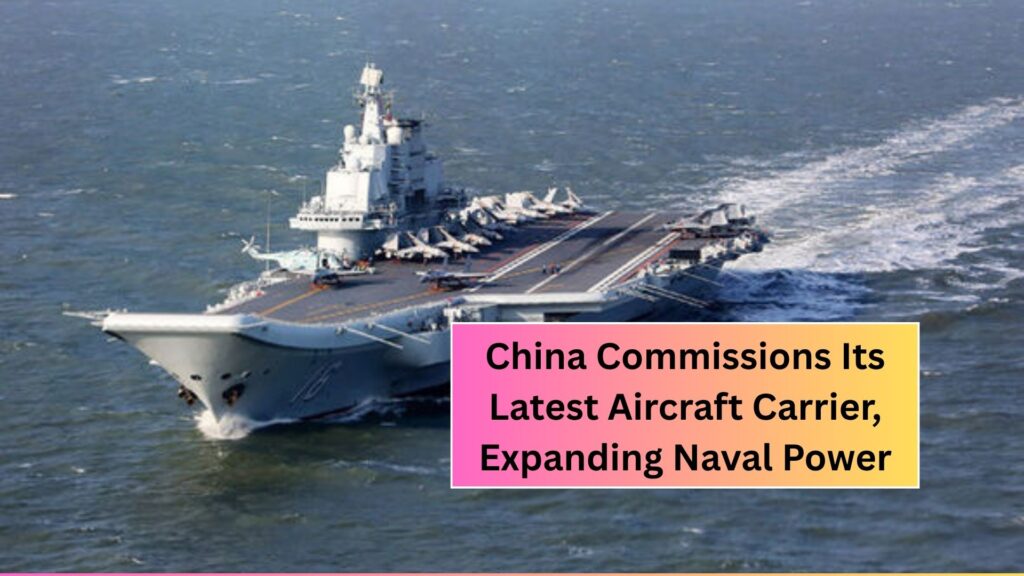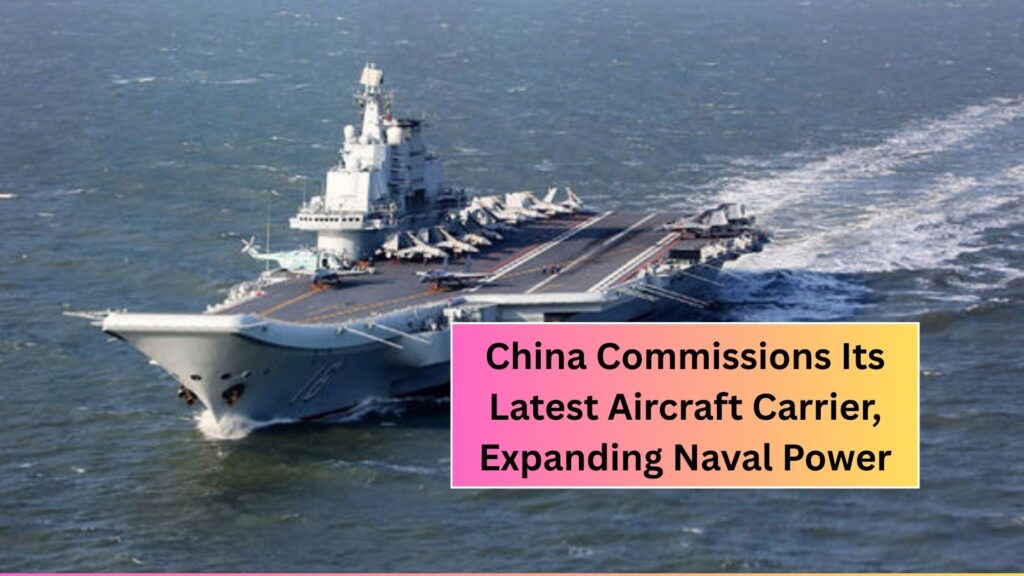When China announces a new aircraft carrier, the whole world takes notice. The commissioning of its latest warship has sparked discussions across defense circles, hinting at a significant leap in the nation’s maritime ambitions. But what exactly makes this carrier such a big deal? Let’s break it down in a simple, engaging way.

The Big Reveal: A New Era for China’s Navy
China has officially commissioned its newest aircraft carrier, a move that signals the country’s growing confidence and capability in naval warfare. This isn’t just another ship — it’s a floating city of technology, power, and strategy.
What Makes This Carrier So Special?
This new carrier, reportedly named Fujian (Type 003), represents a major upgrade from China’s previous two carriers — Liaoning and Shandong. Unlike its predecessors, Fujian features an electromagnetic catapult system, allowing fighter jets to take off with greater efficiency. Think of it as the difference between slingshotting a plane into the sky versus having a full runway boost — faster, smoother, and more powerful.

From Imitation to Innovation
In the early stages, China’s naval developments were often inspired by other countries’ technologies, especially Russia’s. But with the Fujian, things are changing. China is no longer just following; it’s leading. This carrier is a homegrown masterpiece, entirely designed and built in China — a clear sign of the nation’s growing self-reliance in defense tech.
Size Matters: Comparing the Giants
Fujian is massive. Measuring over 300 meters in length and displacing more than 80,000 tons, it’s nearly the size of a U.S. supercarrier. That’s like comparing a luxury cruise liner to a regular ferry — one is built for scale, strength, and dominance.
The Technology Powerhouse on Water
Let’s talk tech. The Fujian is equipped with state-of-the-art systems, including:
- Electromagnetic catapult launchers
- Advanced radar and detection systems
- Stealth-enhanced design
- Next-gen aircraft compatibility
In simple terms, this carrier can launch more planes, detect threats faster, and stay hidden better than before.
A Floating Airbase
Think of an aircraft carrier as a moving airport at sea. It allows China to project power far from its shores. The Fujian can carry up to 60 aircraft, including advanced J-15 fighters and future stealth jets. This means China can conduct missions thousands of miles away, without relying on foreign bases.
Strategic Importance: Beyond the Horizon
Why does this matter so much? Because control of the seas equals influence. The South China Sea, Taiwan Strait, and Pacific regions are becoming hotspots for geopolitical tension. With a stronger navy, China can assert dominance and protect its trade routes — which are crucial for its booming economy.
Global Reactions: The World Watches Closely
No surprise here — the commissioning of the Fujian has made other nations sit up straight. The U.S., Japan, and India are particularly attentive. Each already has strong naval forces, but China’s rapid progress adds a new twist to the global power balance.
The U.S. Comparison: Closing the Gap
Let’s be real — the United States still leads when it comes to naval power. With 11 nuclear-powered carriers, it’s decades ahead. But China’s growing fleet, now the largest in the world by number of ships, shows it’s not backing down anytime soon. The Fujian narrows the technological gap that once seemed too wide.
The Message Behind the Metal
Every major military development carries a message. For China, the Fujian isn’t just about firepower; it’s about national pride, deterrence, and presence. It tells the world, “We’re here, we’re capable, and we’re ready to defend our interests.”
Economic and Industrial Impact
Building a supercarrier isn’t just about military power — it’s also about industrial capability. Thousands of workers, engineers, and shipbuilders were involved in the Fujian project. This not only boosts China’s defense sector but also strengthens its shipbuilding industry, now one of the most advanced globally.
Training and Operations: The Human Factor
While hardware is impressive, it’s the crew that brings it to life. China has been heavily investing in training programs for its naval aviators and crew members. Operating an aircraft carrier takes precision, teamwork, and years of experience — and China is learning fast.
The Future Fleet: More to Come?
Here’s the exciting part — Fujian might just be the beginning. Analysts predict that China could be working on nuclear-powered carriers next, similar to those used by the U.S. This would allow for longer deployments and even greater global reach.
What It Means for Regional Stability
There’s no denying that China’s growing naval strength changes the dynamics in Asia. Some see it as a protective measure, while others view it as an aggressive expansion. Either way, the balance of power in the Indo-Pacific is shifting.
A Step Toward a Blue-Water Navy
The commissioning of the Fujian marks China’s evolution into a blue-water navy — one capable of operating globally, not just near its coastline. This transformation is crucial if China aims to be seen as a true maritime superpower.
Challenges Ahead: Not All Smooth Sailing
Despite the achievement, challenges remain. Mastering carrier operations takes time and experience. The U.S. Navy has been doing this for over 80 years. China’s navy, though progressing rapidly, still has a learning curve to overcome — especially in joint operations and logistics.
The Bigger Picture: Power Projection and Diplomacy
Beyond defense, the Fujian will also play a role in disaster relief, evacuation missions, and peacekeeping efforts. Aircraft carriers often act as symbols of humanitarian reach as much as military might — and China seems keen to showcase both sides of that coin.
How This Affects Global Trade and Security
More carriers mean more control over sea lanes and global trade routes. Considering that over 80% of world trade travels by sea, China’s naval expansion gives it strategic leverage in protecting — and influencing — these routes.
The Symbolism of Power
Aircraft carriers are often seen as floating symbols of national strength. For China, the Fujian isn’t just about warfare; it’s a statement of progress, technology, and ambition. It reflects how far the nation has come in a few decades — from a regional player to a global powerhouse.
The Road Ahead: What to Expect Next
So, what’s next? Expect to see China conducting sea trials, training missions, and international exercises to showcase its naval might. With each deployment, it will refine operations and prove its readiness on the world stage.
Conclusion
China’s latest aircraft carrier, the Fujian, isn’t just another addition to its navy — it’s a declaration of intent. It symbolizes China’s determination to expand its maritime reach, strengthen its defenses, and stand tall among global military powers. While challenges remain, there’s no denying the monumental step this carrier represents for the Chinese navy and the world’s balance of power. Whether you view it as a bold move or a cause for concern, one thing’s clear — the seas just got a lot more interesting.
FAQs
1. What is the name of China’s latest aircraft carrier?
China’s newest aircraft carrier is named Fujian (Type 003), marking its third and most advanced carrier to date.
2. How is the Fujian different from previous Chinese carriers?
Unlike earlier models, the Fujian uses electromagnetic catapult technology and is fully domestically designed and built, signaling a major technological leap.
3. How many aircraft can the Fujian carry?
It can carry around 60 aircraft, including J-15 fighter jets and future stealth aircraft.
4. Is the Fujian nuclear-powered?
No, the Fujian is conventionally powered, though China is reportedly developing nuclear-powered carriers for future use.
5. Why is this carrier significant for China’s global standing?
The Fujian strengthens China’s blue-water capabilities, enhances its regional influence, and showcases its technological independence in naval warfare.